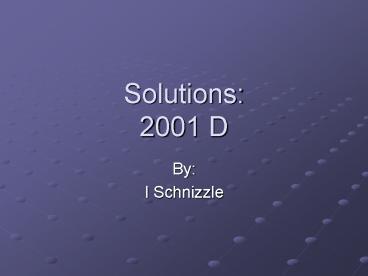Solutions: 2001 D - PowerPoint PPT Presentation
1 / 13
Title:
Solutions: 2001 D
Description:
Solutions: 2001 D By: I Schnizzle 2001 D Part A .1M Pb(NO3)2 /.1M NaCl /.1M KMnO4 /.1M C2H5OH / .1M KC2H3O2 A.) Which solution has the highest boiling point? – PowerPoint PPT presentation
Number of Views:52
Avg rating:3.0/5.0
Title: Solutions: 2001 D
1
Solutions2001 D
- By
- I Schnizzle
2
2001 D Part A
- .1M Pb(NO3)2 /.1M NaCl /.1M KMnO4 /.1M C2H5OH /
.1M KC2H3O2 - A.) Which solution has the highest boiling point?
Explain - The answer to this question can be found by
referring back to the bond strengths within each
of these solutions. - The bond strength of any of these solutions
determines how high or low the boiling point will
be.
3
2001 D Part A Cont
- Since bonds within ionic compounds are stronger
than those within covalent compounds the .1M of
C2H5OH is out. - Than looking at your other four solutions which
are ionic Pb(NO3)2 has the most ions of the
remaining four solutions there for it will have
the highest boiling point.
4
2001 D Part B
- .1M Pb(NO3)2 /.1M NaCl /.1M KMnO4 /.1M C2H5OH /
.1M KC2H3O2 - B.) Which solution has the highest pH? Explain
- The pH level of any solution is determined by how
basic or acidic the solution is. - If a solution has a weak acid and a salt it will
form a more basic solution. This goes for a salt
and weak base as well except the solution would
be more acidic
5
2001 D Part B Cont
- KC2H3O2 is the solution that will have the
highest pH based on the weak acid and salt it
has. - When KC2H3O2 is added to H2O the compound will
dissociate and the weak acid and salt, K in this
case will form new compounds. - With the new compound formed from the weak acid
the new solution will be more basic, and in turn
have higher pH.
6
2001 D Part C
- .1M Pb(NO3)2 /.1M NaCl /.1M KMnO4 /.1M C2H5OH /
.1M KC2H3O2 - C.) Identify a pair of solutions that would
produce a precipitate when mixed together. Write
the formula of the precipitate. - In order to complete this question you must first
have a general understanding of your solubility
rules.
7
2001 D Part C Cont
- After looking over your solubility rules you will
find that Pb2 does not tend to dissolve with
most salts. - Therefore the solutions of Pb(NO3)2 and NaCl are
good solutions that will form a precipitate since
the ions will form new compounds one of which is
PbCl2 which is insoluble.
8
2001 D Part C Cont
- The equation for this new precipitate formed
would be as follows. - Pb(NO3)2 NaCl yields NaNO3 PbCl2
- After balancing this equation the final balanced
equation would be Pb(NO3)2 2NaCl yields 2NaNO3
PbCl2 - Where the PbCl2 is the precipitate formed and is
also the formula of the precipitate.
9
2001 D Part D
- .1M Pb(NO3)2 /.1M NaCl /.1M KMnO4 /.1M C2H5OH /
.1M KC2H3O2 - Which solution could be used to oxidize the
Cl-(aq) ion? Identify the product of the
oxidation. - In order to oxidize something the charge on the
ion becomes more positive so the goal is to find
a solution that allows for Cl-s charge to become
more positive.
10
2001 D Part D Cont
- KMnO4 is a perfect solution for this oxidation to
occur because once the ions of the KMnO4 are
broken down they will oxidize the Cl- the most. - This oxidation occurs and forms the product of
ClO3- which gives the Cl- a more positive charge
of 5
11
2001D Part E
- .1M Pb(NO3)2 /.1M NaCl /.1M KMnO4 /.1M C2H5OH /
.1M KC2H3O2 - E.) Which solution would be the least effective
conductor of electricity? Explain. - First of all good conductors of electricity are
compounds that have ionic bonds within them as
opposed to covalent bonds. - So we are looking for a covalent bonded compound
since that would be the least effective solution
to conduct electricity.
12
2001D Part E Cont
- C2H5OH is the only compound that has covalent
bonds and therefore does not form any ions in
H2O. - Since H2O is also covalently bonded the solution
would be the least likely to be a good conductor
of electricity.
13
BAM!
- The End































